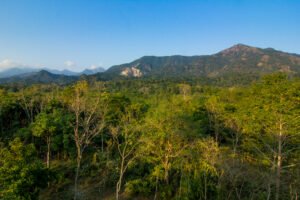List of National Parks in India 2025
Learn about the National Parks in India for Wildlife and Nature Lovers. Explore the beauty of India's 107 National Parks in 2025, spanning 44,402.95 km² of breathtaking landscapes and diverse wildlife. From the iconic Jim Corbett National Park in Uttarakhand, established in 1936, to the newest addition, Similipal National Park in Odisha, these protected areas showcase India's rich biodiversity. Whether you're seeking tiger reserves like Ranthambore or serene ecosystems like Sundarbans, our comprehensive state-wise list provides locations, establishment years, and unique features of every National Park in India. Perfect for UPSC aspirants, eco-tourists, and conservation enthusiasts—dive into India’s natural heritage today.
A national park is a protected area of land, often of significant natural beauty, designated by a national government to preserve wildlife, plants, and their habitats. These areas are managed to conserve biodiversity and offer a safe haven for various species. They also provide opportunities for recreation and scientific study.
Conservation: National parks are crucial for protecting biodiversity, ensuring the survival of endangered species, and maintaining ecological balance.
Recreation: They offer spaces for hiking, camping, wildlife viewing, and other outdoor activities, contributing to public enjoyment and appreciation of nature.
Scientific Research: National parks serve as living laboratories for scientists to study ecosystems, animal behavior, and the impact of environmental changes.
Andaman and Nicobar Islands – 6 National Parks (Additional 3 Button Island National Parks)
Explore 9 stunning national parks in the Andaman and Nicobar Islands, home to tropical forests, rare animals, and pristine beaches, offering unforgettable experiences for every nature lover.
Campbell Bay National Park

Image Credit: DXR, CC BY-SA 4.0, via Wikimedia Commons
- Located on Great Nicobar Island, Andaman and Nicobar Islands. Established: 1992.
- Known for its tropical rainforests and unique marine biodiversity.
Galathea National Park

Image Credit:DickDaniels (http://theworldbirds.org/), CC BY-SA 3.0, via Wikimedia Commons
- Situated on Great Nicobar Island, Andaman and Nicobar Islands. Established: 1992.
- A biodiversity hotspot with mangroves and nesting sites for leatherback turtles.
Mahatma Gandhi Marine National Park

Image Credit:Dvellakat, CC BY-SA 4.0, via Wikimedia Commons
- Located in Wandoor, Andaman and Nicobar Islands. Established: 1983.
- Famous for its coral reefs and diverse marine life, ideal for eco-tourism.
Mount Harriet National Park

Image Credit: Harikrishnan S, CC BY-SA 4.0, via Wikimedia Commons
- Located in South Andaman, Andaman and Nicobar Islands. Established: 1987.
- Offers scenic views and is home to endemic birds like the Andaman wood pigeon.
Rani Jhansi Marine National Park

Image Credit: Julia Sumangil, CC BY-SA 4.0, via Wikimedia Commons
- Located in Ritchie’s Archipelago, Andaman and Nicobar Islands. Established: 1996.
- Known for its mangroves and vibrant marine ecosystems.
Saddle Peak National Park
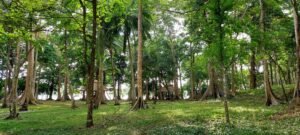
Image Credit: Trip Advisor
- Situated in North Andaman, Andaman and Nicobar Islands. Established: 1987.
- Features lush forests and the highest peak in the Andaman Islands.
* Additional
Button Island National Park
Middle Button Island National Park

Image Credit: Trip Advisor
- Situated in the Andaman and Nicobar Islands. Established: 1987.
- A small island park known for its pristine beaches and coral ecosystems.
North Button Island National Park
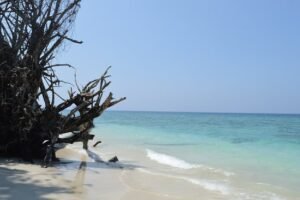
Image Credit: Trip Advisor
- Situated in the Andaman and Nicobar Islands. Established: 1987.
- A tiny island park with rich coral reefs and marine biodiversity.
South Button Island National Park
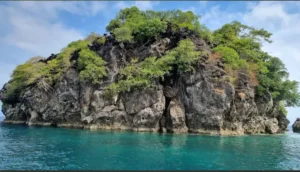
Image Credit: Google
- Located in the Andaman and Nicobar Islands. Established: 1987.
- The smallest national park in India, known for its coral reefs and marine life.
Andhra Pradesh – 3 National Parks
Andhra Pradesh has 3 beautiful national parks, each offering unique landscapes and rich wildlife. From lush forests to rare species, they are a haven for nature lovers and adventure seekers.
Papikonda National Park

Image Credit: Pranayraj1985, CC BY-SA 4.0, via Wikimedia Commons
- Located in East Godavari and West Godavari districts, Andhra Pradesh. Established: 2008.
- Known for its rich biodiversity and scenic hills along the Godavari River.
Sri Venkateswara National Park

Image Credit: Adityamadhav83, CC BY-SA 4.0, via Wikimedia Commons
- Situated in Chittoor and Annamayya districts, Andhra Pradesh. Established: 1989.
- Famous for its diverse flora and fauna, including rare species like the golden gecko.
Rajiv Gandhi National Park (Rameswaram)

Image Credit: Venkat Mangudi, CC BY 2.0, via Wikimedia Commons
- Located in Kadapa district, Andhra Pradesh. Established: 2007.
- A biodiversity hotspot with dry deciduous forests and varied wildlife.
Arunachal Pradesh – 2 National Parks
Arunachal Pradesh has 2 stunning national parks with untouched forests, rare wildlife, and breathtaking views.
Namdapha National Park

Image Credit: Garima Bhatia, CC BY-SA 4.0, via Wikimedia Commons
- Situated in Changlang district, Arunachal Pradesh. Established: 1983.
- One of India’s largest parks, famous for its snow leopards and diverse ecosystems.
Mouling National Park
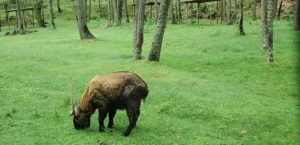
Image Credit: Google
- Located in Upper Siang district, Arunachal Pradesh. Established: 1986.
- Known for its rugged terrain and rare species like the takin.
Assam – 8 National Parks
From the one‑horned rhino to lush tea‑covered hills, Assam’s 8 national parks are a nature lover’s dream.
Dibru-Saikhowa National Park
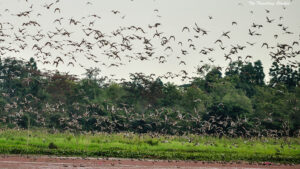
Image Credit : Travelling Slacker
- Located in Dibrugarh and Tinsukia districts, Assam. Established: 1999.
- A stunning park with wetlands, feral horses, and rich birdlife.
Kaziranga National Park
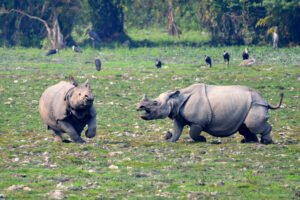
Image Credit: Anuwar ali hazarika, CC BY-SA 4.0,
- Situated in Golaghat and Nagaon districts, Assam. Established: 1974.
- A UNESCO World Heritage Site, home to two-thirds of the world’s one-horned rhinos.
Manas National Park
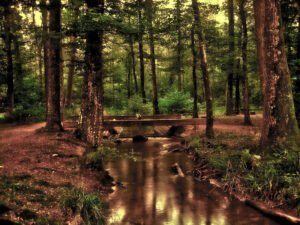
Image Credit: Avermaram, CC BY-SA 4.0,
- Located in Barpeta and Baksa districts, Assam. Established: 1990.
- A UNESCO World Heritage Site known for its tigers and Assam roofed turtle.
Nameri National Park

Image Credit: Dadul77, CC BY-SA 4.0, via Wikimedia Commons
- Situated in Sonitpur district, Assam. Established: 1998.
- Famous for its elephant population and birdwatching opportunities.
Orang National Park
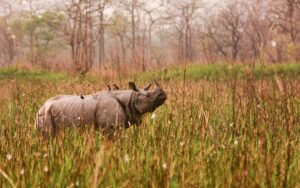
Image Credit: By Nejib Ahmed , Own work, CC BY-SA 4.0, Link
- Located in Darrang and Sonitpur districts, Assam. Established: 1999.
- Known as the “Mini Kaziranga” for its rhinos and diverse wildlife.
Raimona National Park
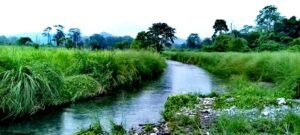
Image Credit: By Nayan j Nath – Own work, CC BY-SA 4.0, Link
- Situated in Kokrajhar district, Assam. Established: 2021.
- Known for its golden langur population and lush forests in the Bodoland region.
Dehing Patkai National Park

Image Credit: Dibyendu Ash, CC BY 4.0,
- Located in Dibrugarh and Tinsukia districts, Assam. Established: 2021.
- A lowland rainforest called the “Amazon of the East” for its unique biodiversity.
Sikhna Jwhwlao National Park

Image Credit: MaheshBaruahwildlife, CC BY-SA 4.0,
- Located in Kokrajhar and Chirang districts. Established: 2025 .
- This 316 km² park protects elephants and diverse flora along the India-Bhutan border.
Bihar – 1 National Park
Valmiki National Park, Bihar's only national park, spans 898.45 sq km, harboring Bengal tigers, leopards, and over 200 bird species in its dense sal forests and wetlands.
Valmiki National Park
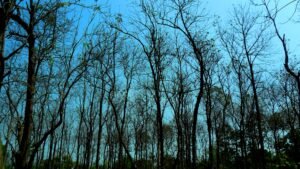
Image Credit:Praanshu, CC BY-SA 4.0
- Located in West Champaran district, Bihar. Established: 1990.
- Known for its tigers and proximity to the Indo-Nepal border
Chhattisgarh – 3 National Parks
hattisgarh’s three national parks—Guru Ghasidas, Indravati, and Kanger Valley—cover diverse ecosystems, from sal forests to limestone caves, hosting Bengal tigers, wild buffalo, and the Bastar hill myna across 2,880 sq km
Guru Ghasidas (Sanjay) National Park
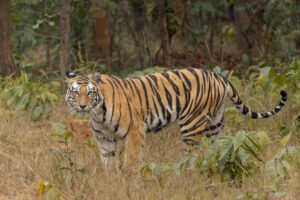
Image Credit:By Tisha Mukherjee – Own work, CC BY-SA 4.0, Link
- Situated in Koriya and Surajpur districts, Chhattisgarh. Established: 1981.
- A large park known for its tigers and diverse forest ecosystems.
Indravati National Park

- Located in Bijapur district, Chhattisgarh. Established: 1981.
- Famous for its wild buffalo population and dense forests.
Kanger Valley National Park
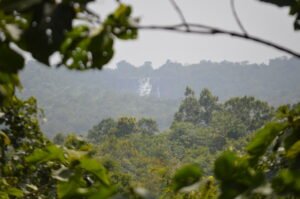
Image credit:Harminder singh saini, CC BY-SA 4.0,
- Situated in Bastar district, Chhattisgarh. Established: 1982.
- Known for its limestone caves and rich biodiversity.
Goa – 1 National Park
Bhagwan Mahaveer Sanctuary and Mollem National Park is a 240 square kilometres (93 sq mi) protected are located in the Western of West India, featuring lush forests and diverse wildlife including gaur, leopards, and over 200 bird species.
Mollem National Park

- Located in South Goa district, Goa. Established: 1978.
- Part of the Bhagwan Mahaveer Sanctuary, known for its leopards and waterfalls.
Gujarat – 4 National Parks
Gujarat’s four national park host unique ecosystems, from Asiatic lions in Gir’s dry deciduous forests to blackbuck antelopes in Velavadar’s grasslands, vibrant coral reefs in the Gulf of Kutch, and dense teak forests in Vansda
Blackbuck (Velavadar) National Park
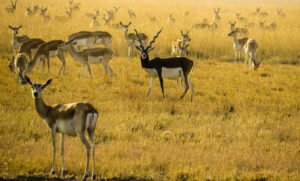
Image Credit:Panchasarakrutarth, CC BY-SA 4.0,
- Located in Bhavnagar district, Gujarat. Established: 1976.
- Renowned for its large blackbuck antelope population and grasslands.
Gir National Park

Image Credit:Sumeet Moghe, CC BY-SA 4.0,
- Situated near Talala, Junagadh district, Gujarat. Established: 1965.
- The only habitat of the Asiatic lion, with a thriving ecosystem.
Marine National Park

Image Credit:Jan Joseph George, CC BY-SA 4.0,
- Located on the southern coast of the Gulf of Kutch, Jamnagar district, Gujarat. Established: 1982.
- India’s first marine national park, known for its coral reefs and marine life.
Vansda National Park
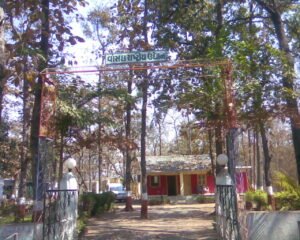
Image Credit: The original uploader was સતિષચંદ્ર at Gujarati Wikipedia., CC BY-SA 3.0, via Wikimedia Commons
- Situated in Navsari district, Gujarat. Established: 1979.
- A lush park with dense forests, home to leopards and diverse bird species.
Haryana – 2 National Parks
Haryana’s two national parks—Sultanpur (1.43 sq km) and Kalesar (46.82 sq km)—offer distinct ecosystems, with Sultanpur’s wetlands hosting over 250 migratory bird species and Kalesar’s sal forests sheltering leopards and diverse flora.
Kalesar National Park
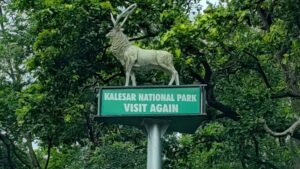
Image Credit: Chirag1745,
- Located in Yamunanagar district, Haryana. Established: 2003.
- Known for its sal forests and wildlife, including leopards and elephants.
Sultanpur National Park
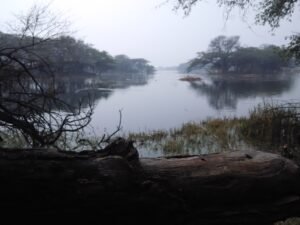
Image Credit:Vishalbhatia93, CC BY-SA 4.0, via Wikimedia Commons
- Situated in Gurugram district, Haryana. Established: 1989.
- A haven for migratory birds, offering a serene wetland ecosystem.
Himachal Pradesh – 5 National Parks
Himachal Pradesh’s five national parks—Great Himalayan (754.4 sq km), Pin Valley (675 sq km), Khirganga (710 sq km), Inderkilla (104 sq km), and Simbalbara (27.88 sq km)—feature diverse ecosystems, from alpine meadows and snow leopards in Pin Valley to dense deodar forests and leopards in Simbalbara
Pin Valley National Park
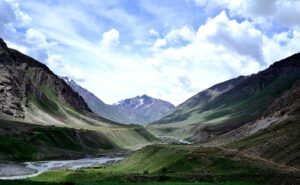
- Located in Lahaul and Spiti district, Himachal Pradesh. Established: 1987.
- A high-altitude park known for its rugged landscapes and snow leopards.
Great Himalayan National Park
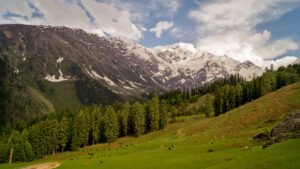
Image Credit : Suresh Karia, CC BY-SA 4.0,
- Situated in Kullu district, Himachal Pradesh. Established: 1984.
- A UNESCO World Heritage Site, famous for its biodiversity and Himalayan vistas.
Inderkilla National Park

- Located in Kullu district, Himachal Pradesh. Established: 2010.
- Known for its scenic beauty and diverse flora and fauna.
Khirganga National Park
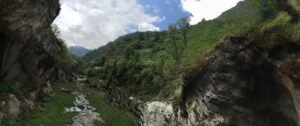
Image Source:ArjunChhibber01, CC BY-SA 4.0,
- Situated in Kullu district, Himachal Pradesh. Established: 2010.
- Famous for its hot springs and high-altitude trekking routes.
Simbalbara National Park
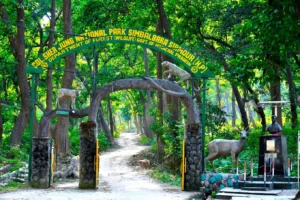
- Located in Sirmaur district, Himachal Pradesh. Established: 2010.
- A small park known for its goral and deer populations.
Jammu and Kashmir – 4 National Parks
Jammu and Kashmir has 4 national parks. These are Dachigam (141 sq km), Hemis (4,400 sq km), Kishtwar (2,190.5 sq km), City Forest (Salim Ali) (9 sq km), and Kazinag (117.97 sq km), showcasing diverse ecosystems from Himalayan meadows hosting hangul and snow leopards to coniferous forests with markhor and Himalayan monal.
Dachigam National Park
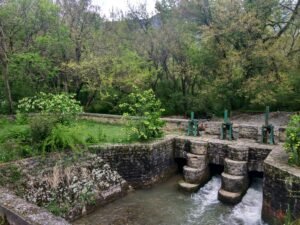
Image Credit: Jyoti Chaurasia, CC BY-SA 4.0,
- Located near Srinagar, Jammu and Kashmir. Established: 1981.
- Known for its Hangul (Kashmir stag) and scenic Himalayan landscapes.
Kishtwar National Park
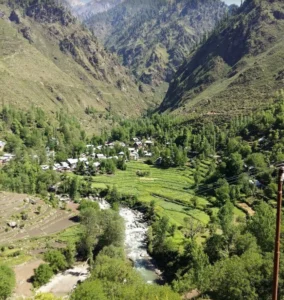
- Situated in Kishtwar district, Jammu and Kashmir. Established: 1981.
- A high-altitude park with snow leopards and Himalayan ibex.
Salim Ali National Park

- Located in Srinagar, Jammu and Kashmir. Established: 1992.
- Named after the famous ornithologist Dr. Salim Ali , known for its bird diversity.
Hemis National Park

Image Credit:Sundeep bhardwaj, CC BY 3.0,
- Situated in eastern Ladakh, Leh district. Established: 1981.
- India’s largest national park (4,400 km²), famous for snow leopards and high-altitude lakes
Ladakh – 1 National Park
Ladakh’s sole national park, Hemis, spans 4,400 sq km, renowned for its high-altitude Himalayan ecosystem, home to snow leopards, bharal, and over 73 bird species.
Hemis National Park-1

- Located in eastern Ladakh. Established: 1981.
- The largest national park in India, famous for its snow leopards.
Jharkhand – 1 National Park
Jharkhand’s sole national park, Betla, spans 226.33 sq km, featuring dense sal forests and rolling hills, home to elephants, tigers, and diverse birdlife
Betla National Park
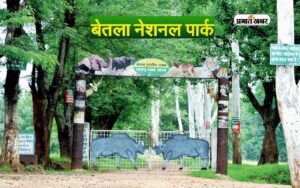
- Located in Latehar and Palamu districts, Jharkhand. Established: 1986.
- Known for its tigers and scenic forests in the Chota Nagpur Plateau.
Karnataka – 5 National Parks
Karnataka’s five national parks—Bandipur (872.24 sq km), Nagarhole (643.39 sq km), Anshi (417.37 sq km), Kudremukh (600.32 sq km), and Bannerghatta (260.51 sq km)—encompass diverse ecosystems, from Bandipur’s dry deciduous forests hosting tigers and elephants to Anshi’s Western Ghats with hornbills and Kudremukh’s shola grasslands sheltering lion-tailed macaques
Anshi National Park
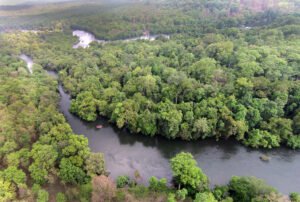
Image Credit:Amoghavarsha, CC BY-SA 4.0,
- Located in Uttara Kannada district, Karnataka. Established: 1987.
- Known for its rich biodiversity, including tigers and king cobras.
Bandipur National Park
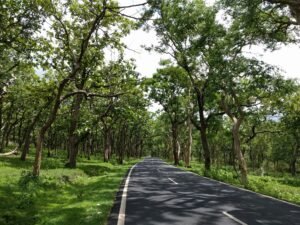
Image Credit:Aditya945, CC BY-SA 4.0,
- Situated in Chamarajanagar district, Karnataka. Established: 1974.
- A key tiger reserve known for its elephants and sandalwood forests.
Bannerghatta National Park
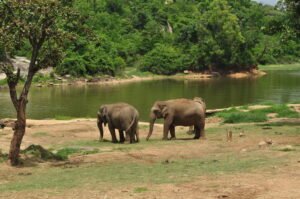
Image Credit:Rishitshivesh1017, CC BY-SA 4.0,
- Located near Bengaluru, Karnataka. Established: 1974.
- Famous for its butterfly park and lion-tiger safari.
Kudremukh National Park
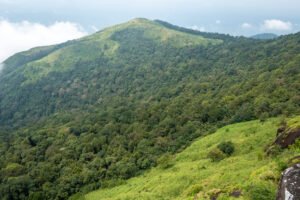
Image Credit:Mike Prince from Bangalore, India, CC BY 2.0,
- Situated in Chikkamagaluru district, Karnataka. Established: 1987.
- Known for its shola forests and the Kudremukh peak.
Nagarhole National Park
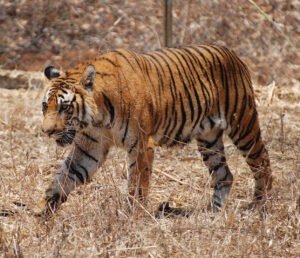
Image Credit:Paul Mannix, CC BY 2.0,
- Located in Kodagu and Mysuru districts, Karnataka. Established: 1988.
- A major tiger reserve with diverse wildlife and the Kabini River.
Kerala – 6 National Parks
Kerala’s six national parks—Periyar , Eravikulam, Silent Valley, Anamudi Shola , Mathikettan Shola, and Pampadum Shola span diverse ecosystems of the Western Ghats, hosting endangered species like the Nilgiri tahr, lion-tailed macaque, and Neelakurinji flowers, with establishment years as follows: Periyar (1982), Eravikulam (1978), Silent Valley (1984), Anamudi Shola (2003), Mathikettan Shola (2003), and Pampadum Shola (2003).
Anamudi Shola National Park
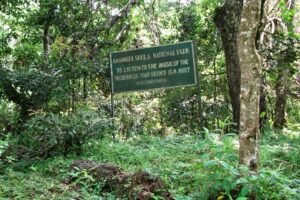
Image credit:Jaseem Hamza, CC BY 3.0,
- Located in Idukki district, Kerala. Established: 2003.
- A biodiversity-rich park with shola forests and rare flora and fauna.
Eravikulam National Park
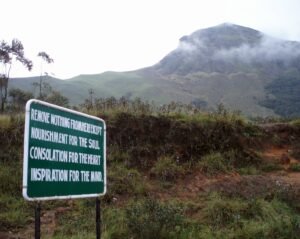
- Situated in Idukki district, Kerala. Established: 1978.
- Home to the endangered Nilgiri tahr and the Anamudi peak.
Mathikettan Shola National Park

Image Credit:Arayilpdas at Malayalam Wikipedia, CC BY-SA 3.0,
- Located in Idukki district, Kerala. Established: 2003.
- Known for its shola forests and elephant migration routes.
Pambadum Shola National Park

Image Credit: Jaseem Hamza, CC BY 3.0,
- Situated in Idukki district, Kerala. Established: 2003.
- The smallest national park in Kerala, known for its Nilgiri marten.
Periyar National Park

Image Credit:SHYAMAL CHANDRA GHOSH, CC BY-SA 4.0,
Located in Idukki and Pathanamthitta districts, Kerala. Established: 1982.
A major tiger reserve with a scenic lake and elephant sightings.
Silent Valley National Park
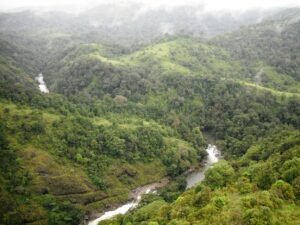
Image Credit:Jaseem Hamza, CC BY 3.0,
- Situated in Palakkad district, Kerala. Established: 1984.
- Known for its pristine rainforests and rare lion-tailed macaques.
Madhya Pradesh – 11 National Parks
Madhya Pradesh, known as the “Heart of India,” is home to 11 national parks, each with unique ecosystems and rich biodiversity, covering a total of approximately 4,349.14 sq km.
Bandhavgarh National Park
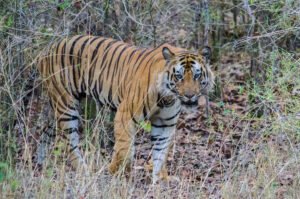
Image Credit:Santanu Bahali, CC BY-SA 4.0, via Wikimedia Commons
- Located in Umaria district, Madhya Pradesh. Established: 1968.
- Famous for its high density of Royal Bengal tigers and historic Bandhavgarh Fort.
Kanha National Park
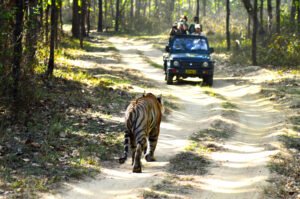
Image Credit:Ashishmahaur, CC BY-SA 4.0,
- Situated in Mandla and Balaghat districts, Madhya Pradesh. Established: 1955.
- The largest national park in Madhya Pradesh, known for barasingha conservation.
Madhav National Park

Image Credit:Chitra2016, CC BY-SA 4.0,
- Located in Shivpuri district, Madhya Pradesh. Established: 1958.
- Known for its historical significance and diverse wildlife like chital and leopards
Panna National Park

Image Credit:Mehaknoni, CC BY-SA 4.0,
- Situated in Panna and Chhatarpur districts, Madhya Pradesh. Established: 1981.
- Famous for its diamond mines and successful tiger reintroduction program.
Pench National Park
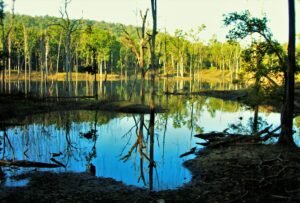
Image Credit:Ishani Mehta, CC BY-SA 4.0,
- Located in Seoni and Chhindwara districts, Madhya Pradesh Established: 1983 as National park and wild life sanctuary until 1975
- inspiration for The Jungle Book, known for its lush forests.
Sanjay-Dubri National Park

Image Credit:Tisha Mukherjee, CC BY-SA 4.0,
- Situated in Sidhi and Singrauli districts, Madhya Pradesh. Established: 1981.
- Known for its sal forests and diverse wildlife, part of Sanjay-Dubri Tiger Reserve
Satpura National Park
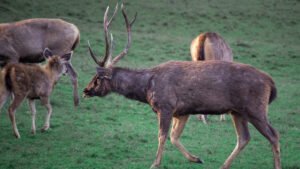
Image Credits:BSSKrishnaS, CC BY-SA 4.0,
- Located in Narmadapuram district, Madhya Pradesh. Established: 1981.
- Famous for its rugged terrain and diverse fauna, including sloth bears.
Van Vihar National Park

Image Credit:Suyash Dwivedi, CC BY-SA 4.0,
- Situated in Bhopal, Madhya Pradesh. Established: 1979.
- A unique urban park with a zoo-like setup for rescued animals.
Ghughua Fossil National Park

Image Credit :By NJneeraj – Own work, CC BY-SA 4.0, Link
- Ghughwa National Park can be considered the smallest national park in the entire state.
- It is blessed with a priceless treasure trove of plant fossils that existed in India anywhere between 40 million and 150 million years ago.
- This area was designated as the Ghughwa Fossil National Park in 1983 and it is spread over about 75 acres of land.
Kuno National Park
- Located in Sheopur and Morena districts Covering an area of 404 sq km. Established: 2018.
- A key site for cheetah and potential Asiatic lion reintroduction, with diverse wildlife like blackbuck.
Dinosaur Fossil National Park

Image Credit:FabSubeject, CC BY-SA 3.0,
- Located in Dhar district, Located in Bagh, Dhar district, Madhya Pradesh. Established: 2011.
- this national park preserves the fossilised remains of dinosaurs that roamed the region millions of years ago.
Maharashtra – 6 National Parks
Maharashtra, the “Gateway of India,” hosts six national parks, each showcasing diverse ecosystems from Western Ghats forests to coastal wetlands, covering approximately 1,354.83 sq km.
Chandoli National Park
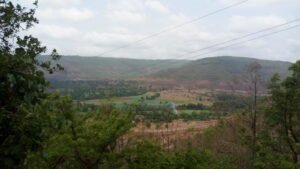
Image Credit: Atharvk9, CC BY-SA 4.0,
- Located in Satara, Sangli, Kolhapur, and Ratnagiri districts, Maharashtra. Established: 2004.
- Known for its Malabar pied hornbills and dense forests.
Gugamal National Park
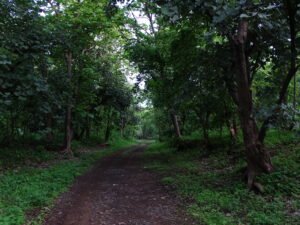
Image Credit:Ankitfunk, CC BY-SA 4.0,
- Situated in Amravati district, Maharashtra. Established: 1974.
- Part of the Melghat Tiger Reserve, known for its dense forests.
Navegaon National Park

Image Credit:Anayst, CC BY-SA 3.0,
- Located in Gondia district, Maharashtra. Established: 1975.
- Famous for its lake and diverse bird species.
Pench National Park
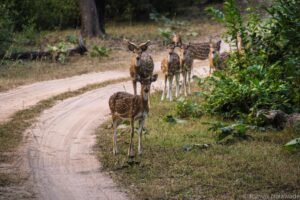
Image Credit:Rutwik Nalawade, CC BY-SA 4.0,
- Situated in Nagpur district, Maharashtra (shared with Madhya Pradesh). Established: 1975.
- Known for its tigers and as part of The Jungle Book setting.
Sanjay Gandhi National Park
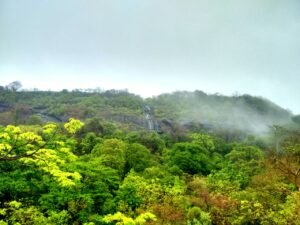
Image Credit:Shreesh Deshpande, CC BY-SA 4.0,
- Located in Mumbai, Maharashtra. Established: 1983.
- An urban park with leopards and the ancient Kanheri Caves.
Tadoba Andhari National Park
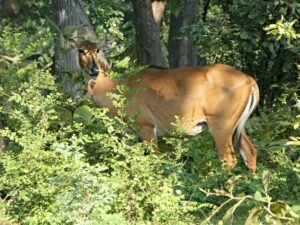
- Situated in Chandrapur district, Maharashtra. Established: 1955.
- A prominent tiger reserve known for its dense forests and wildlife.
Manipur – 2 National Parks
Explore the two enchanting national parks in Manipur, showcasing unique ecosystems, rare wildlife, and vibrant biodiversity, offering unforgettable adventures for nature enthusiasts.
Keibul Lamjao National Park
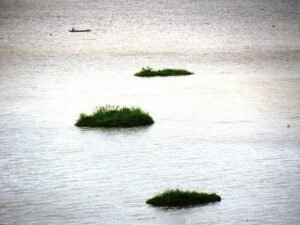
Image Credit:Ranjan Jyoti Dutta, CC BY-SA 4.0,
- Located in Bishnupur district, Manipur. Established: 1977.
- The world’s only floating national park, home to the sangai deer.
Sirohi National Park
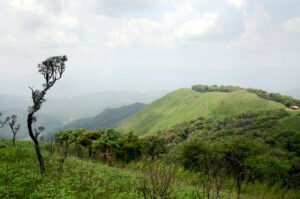
Image Credit:G Devadarshan Sharma, CC BY-SA 4.0,
- Situated in Imphal East district, Manipur The national park is named after the Shirui Lily (Lilium mackliniae), a rare and endangered
- flower species that is found in the park. The Shirui Lily is the state flower of Manipur and is known for its vibrant colors and exquisitebeauty
- The park was established in 1982 primarily to protect and conserve this unique flower species and diverse bird species.
Meghalaya – 2 National Parks
the two captivating national parks in Meghalaya, nestled in lush hills and rich biodiversity, offering unforgettable experiences for nature lovers and adventurers.
Balphakram National Park
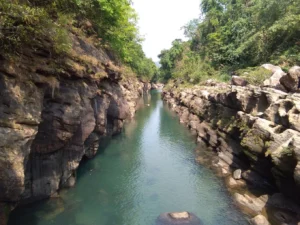
- Located in South Garo Hills, Meghalaya. Established: 1986. covering approximately 220 sq km, is known for its rugged terrain, deep gorges, and biodiversity, including species like barking deer, wild water buffalo, and occasionally leopards
Nokrek National Park

Image Credit:Baharul Choudhury, Concordia University, via BMC Ecology, CC BY 2.0,
- Situated in West Garo Hills, Meghalaya. Established: 1986.
- A UNESCO Biosphere Reserve, known for its citrus gene pool.
Mizoram – 2 National Parks
Immerse yourself in the serene beauty of Mizoram’s two national parks, where lush forests, towering peaks, and rare wildlife create a captivating haven for nature lovers.
Murlen National Park
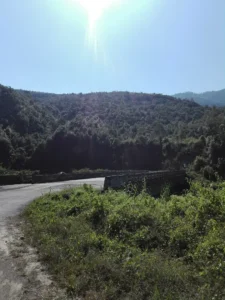
- The Murlen National Park is located near the Indo-Myanmar border Covering approx 200 km2 in the Champhai district off Mizoram Established in 1991.
- Renowned for its Amazon-like dense forests and unique bird species.
Phawngpui Blue Mountain National Park
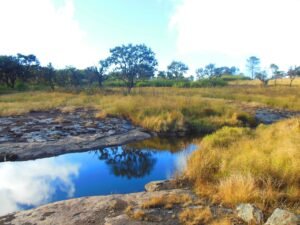
Image Source:By Garima Singh – Own work, CC BY-SA 4.0, Link
- Situated in Lawngtlai district, Mizoram. Established: 1992.Crowned by Phawngpui, Mizoram’s highest peak and rare orchids.
- it hosts leopards, slow loris, and vibrant biodiversity.Scenic trails near the Myanmar border offer breathtaking views and tranquil retreats.
Nagaland – 1 National Park
Nagaland is home to a single national park, Ntangki National Park (also called Intanki National Park). Nestled in Peren district, it was first established as a reserved forest in 1923 and later declared a national park in 1993.
Intanki National Park

- Located in Peren district, Nagaland. Known for its hoolock gibbons and dense evergreen forests.
Odisha – 2 National Parks
Step into the peaceful beauty of Odisha’s two national parks, where green mangroves and thick forests are home to rare animals, creating a special place for nature lovers.
Bhitarkanika National Park
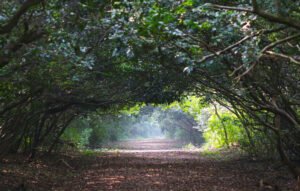
Image Source:Rupeshsarkar, CC BY-SA 4.0,
- Located in Kendrapara district, Odisha. Established: 1998.
- Famous for its mangrove ecosystems and saltwater crocodiles.
Simlipal National Park
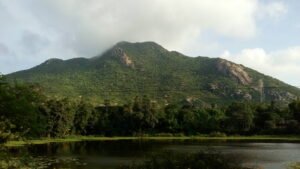
Image Credits:By Sreejeetmaity1998 – Own work, CC BY-SA 4.0, Link
- Situated in Mayurbhanj district, Odisha. Established: 1980 (notified as 107th national park in 2025).
- A tiger reserve known for its unique melanistic tigers.
Rajasthan – 5 National Parks
Explore vibrant heart of Rajasthan’s five national parks, where arid deserts, lush wetlands, and dense forests cradle , crafting a timeless sanctuary for nature lovers. Together, these parks span approximately 4,054.83 sq km, preserving Rajasthan’s rich biodiversity. crafting an unforgettable sanctuary for nature lovers.
Sariska Tiger Reserve
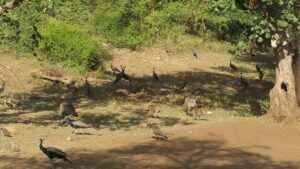
Image Credit:Rprishi, CC BY-SA 4.0,
- Located in Alwar district, Rajasthan. Established in 1982, covering 273.8 sq km.
- A prominent tiger reserve with rugged terrain and historical ruins.
Ranthambore National Park
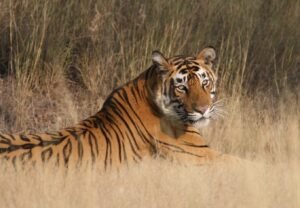
Image Credit:LuisVilla, CC BY 3.0,
- Situated in Sawai Madhopur district, Rajasthan. Established: 1980.
- One of India’s most famous parks known for its tigers and fort. Features lakes, ravines, and dry deciduous forests teeming with leopards and sambar deer.
Mukundra Hills National Park
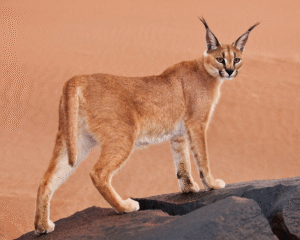
- Located in Kota district, Rajasthan. Established: 2004 and Received as a Tiger Reserve in 2013
- Also known as Darrah Wildlife Sanctuary, known for its leopards, sloth bears, and diverse flora along the Chambal River.
Desert National Park
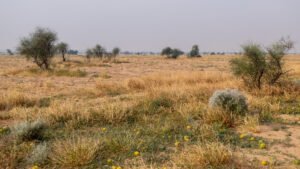
Image Credit:Mike Prince from Bangalore, India, CC BY 2.0,
- The Desert National Park covers an area of 3162 km² of which 1900 km² is in Jaisalmer district and remaining 1262 km² is in Barmer district of Rajasthan Establishedin, 1980.
- Famed for its vast Thar Desert ecosystem and endangered Great Indian Bustard BirdsHosts chinkaras, desert foxes, and ancient fossils amidst sweeping sand dunes.
Keoladeo National Park
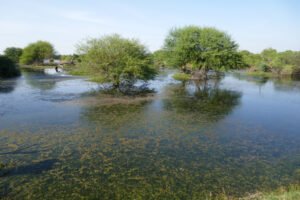
Image Credit:Ji-Elle, CC BY-SA 4.0,
- Located in Bharatpur district, Rajasthan. Established: 1981.
- A UNESCO World Heritage Site, renowned for its migratory bird populations.
- Features wetlands hosting Siberian cranes, painted storks, and over 370 bird species
Sikkim – 1 National Parks
Step into the majestic embrace of Sikkim’s sole national park, Located at the heart of the Himalayan range in northern India (State of Sikkim), the Khangchendzonga National Park includes a unique diversity of plains, valleys, lakes, glaciers and spectacular, snow-capped mountains covered with ancient forests, including the world’s third highest peak, Mount Khangchendzonga. This park covers approximately 1,784 sq km, preserving Sikkim’s rich Himalayan biodiversity.
Khangchendzonga National Park
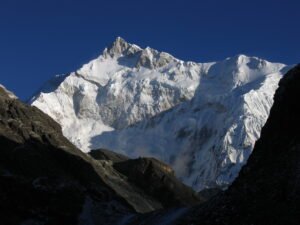
Image Credit:Ashinpt at enwiki, CC BY-SA 3.0,
- Located in North and West Sikkim districts, Sikkim. Established: 1977.
- A UNESCO World Heritage Site, home to the third-highest peak in the world.
Tamil Nadu – 5 National Parks
Immerse yourself in the vibrant embrace of Tamil Nadu’s five national parks, where lush forests, misty hills, and coastal mangroves shelter rare wildlife, creating a timeless sanctuary for nature lovers. Together, these parks span approximately 858.29 sq km, preserving Tamil Nadu’s rich biodiversity.
Mudumalai National Park
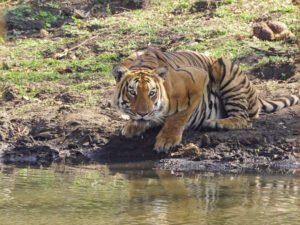
Image Credit:Timothy A. Gonsalves, CC BY-SA 4.0,
- Located in Nilgiri district, Tamil Nadu. Established in 1940, It covers 321 km2 (124 sq mi) at an elevation range of 850–1,250 m (2,790–4,100 ft) in the Nilgiri District and shares boundaries with the states of Karnataka and Kerala.
- Its a Part of the Nilgiri Biosphere Reserve, Offers thrilling safaris and stunning views of the Nilgiri Hills.
- The park receives around 1,420 mm (56 inches) of annual rainfall, supporting tropical and subtropical moist broadleaf forests with 498 plant species, over 266 bird species, 18 carnivore species, and 10 herbivore species.
Mukurthi National Park
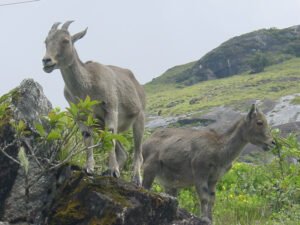
Image Credit:By Rajeshdxb at English Wikipedia – Photo by Rajeshdxb, Public Domain, Link
- Mukurthi National Park is a 78.46 km2 (30.29 sq mi) national park in the western Nilgiris mountains of Tamil Nadu in South India in Nilgiri district, Tamil Nadu. Established on 15th October 1990 (declared a wildlife sanctuary on 3 August 1982 and upgraded to a national park on 15 October 1990)
- it is a UNESCO World Heritage Site since 1 July 2012
Known for its Nilgiri tahr and shola grasslands Nestled in the Western Ghats, - it features rolling grasslands and clear streams.A vital conservation area near Ooty, perfect for trekking.
Guindy National Park
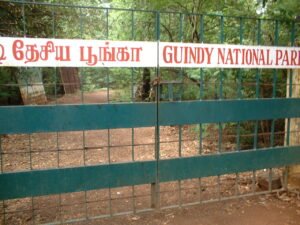
Image Credit:By abhidg – originally posted to Flickr as guindy national park, CC BY 2.0, Link
- Guindy National Park is a protected area, located in Chennai, India. Spread across 2.70 km2 (1.04 sq mi), it is one of the smallest National Parks in India and one of the few national parks situated inside a metropolitan area.
- home to a variety of species including a wide variety of snakes, geckos, tortoises, over 130 species of birds, 14 species of mammals including 400 blackbucks, 2,000 spotted deer, 24 jackals, over 60 species of butterflies and spiders.
Gulf of Mannar Marine National Park

Credit Image:SabaNayagam V, CC BY-SA 4.0, via Wikimedia Commons
- Situated along the coast of Ramanathapuram and Thoothukudi districts, Tamil Nadu. It's the first marine biosphere reserve in South Asia.
- the Gulf of Mannar Marine National Park is one of the richest regions on Earth in terms of biodiversity,Established in 1986.
- Famous for its coral reefs, marine biodiversity, and endangered dugongs.
- declared a Biosphere Reserve in 1989 under the UNESCO Man and Biosphere Programme.
- Encompasses 21 islands, supporting sea turtles, dolphins, and over 3,600 marine species.
Anamalai Tiger Reserve

Image Credit:By UdayKiran28 – Own work, CC BY-SA 4.0, Link
- Anaimalai Tiger Reserve, previously known as Indira Gandhi Wildlife Sanctuary and National Park and later as Anaimalai Wildlife Sanctuary, is a protected area located in the Anaimalai Hills across Pollachi and Valparai taluks in Coimbatore District and Udumalaipettai taluk in Tiruppur District, Tamil Nadu, India. On 27 June 2007.
- Anamalai Tiger Reserve is primarily a sanctuary for the preservation of tigers. However, the area is home to a wide Animal and Plants that attract tourists from far and wide. Some of the animal species excluding the Bengal Tiger here include Indian Elephant, Indian Leopard, Nilgiri Tahr, Lion-tailed Macaque, Gaur, Nilgiri Langur, Sambar Deer, Sloth Bear Malabar Spiny Dormouse and so on.
Telangana – 3 National Parks
Wander into the serene charm of Telangana’s three national parks, where urban retreats and expansive forests nurture vibrant wildlife, creating a treasured sanctuary for nature enthusiasts. Collectively, these parks span approximately 172.01 sq km, preserving Telangana’s natural legacy.
Kasu Brahmananda Reddy National Park
Image Credit:Karumudi – Own work, CC BY-SA 3.0, Link
- Kasu Brahmananda Reddy National Park located in Jubilee Hills and Banjara Hills in Hyderabad, Telangana, India. The park has an approximate area of 390-acre (1.6 km2) and was declared as a National park by the Andhra Pradesh state government after getting approval from the central government in the year 1998.
- The park has over 600 species of plant life, 140 species of birds and 30 different varieties of butterflies and reptiles. Some of the animals making their home in the park include: pangolin, small Indian civet, peacock, jungle cat and porcupines
Mahavir Harina Vanasthali National Park
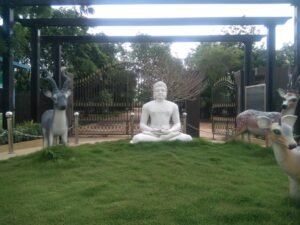
Image Credit: Adbh266, CC BY-SA 4.0,
- Mahavir Harina Vanasthali National Park is a deer national park located in Vanasthalipuram, Hyderabad, Telangana, India. t is spread over 3605 acres. It is the largest green lung space in the city of Hyderabad.
- The park was named after Mahavir, the 24th Tirthankara of Jainism, in commemoration of his 2500th nirvan anniversary in the year 1975.
- Animals living in this national park include a few hundred blackbucks (the state animal of Andhra Pradesh), chitals, porcupines, water monitors, short-toed eagles, Indian pond herons, egrets, kingfishers, cormorants and several other bird species
Mrugavani National Park
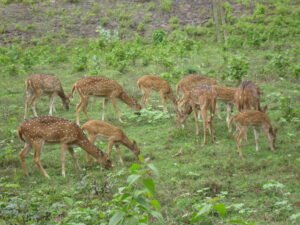
Image Credits:LIC Habeeb at Malayalam Wikipedia, CC BY-SA 3.0, via Wikimedia Commons
- Mrugavani National Park situated at Chilkur in Moinabad mandal Hyderabad, Telangana covers overs an area of 3.6 square kilometres or 1211 acres and was declared as national park in 1994.
- It is home to a 600 different types of plant life. The Park is home to around 350 spotted deers. The animals include: indian hare, forest cat, civet, Indian rat snake, Russell’s viper, cheetal and the flower pecker.
Tripura – 2 National Parks
Delve into the tranquil beauty of Tripura’s two national parks, where lush woodlands and serene vistas nurture rare wildlife, crafting a peaceful retreat for nature enthusiasts. Collectively, these parks cover approximately 35.48 sq km, preserving Tripura’s rich natural heritage.
Clouded Leopard National Park

Image Credit:Rushenb, CC BY-SA 4.0, via Wikimedia Commons
- Clouded Leopard National Park is situated in Tripura and lies within the Sepahijala Wildlife Sanctuary, it is India's first dedicated wildlife park for Clouded Leopard that established in 2007.
- Thew park is known for its clouded leopards and dense forests it also is home to four species of primate monkey including Phayre's langur.
Rajbari National Park
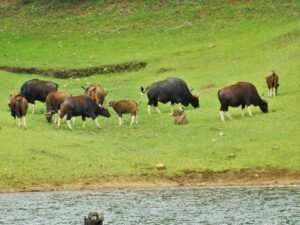
- Situated in the Trishna Wildlife Sanctuary, the Rajbari National Park is one of India’s well-known National Parks. The park is spread over a whopping 31.63 square kilometres Situated in Sepahijala district, Tripura Established in 2007.
- Rajbari National Park is There are several herbs, shrubs, tree species, climbers etc. There Are Four types of forests can be found in this Sanctuary, they are Tropical Semi-Evergreen Forest,East Himalayan lower Bhabar sal,Moist mixed deciduous Forest Savannah woodland.
Uttar Pradesh – 1 National Park
Step into the peaceful embrace of Uttar Pradesh’s only national park, where lush marshes and thick forests cradle unique wildlife, creating a calm sanctuary for nature lovers. Covering roughly 490.3 sq km, with an additional 190 sq km buffer zone, it safeguards the state’s vibrant Terai ecosystem.
Dudhwa National Park
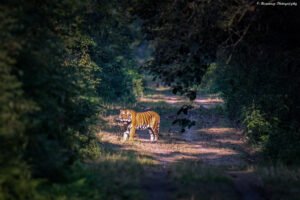
Image Credit: Biswarup11, CC BY-SA 4.0, via Wikimedia Commons
- The area of today's Dudhwa National Park was established in 1958 as a wildlife sanctuary for swamp deer. It was notified as a national park in January 1977 It is part of the Dudhwa Tiger Reserve in the Kheri and Lakhimpur districts
- Known for its swamp deer and tiger population. Dudhwa National Park is home to diverse wildlife species including swamp deer, sambar deer, barking deer, spotted deer, hog deer, Bengal tiger etc.
- From 1977 to 2022, the Barasingha (swamp deer) population in Dudhwa National Park increased from 3,691 to 6,137. Likewise, Chital (spotted deer) numbers grew from 22,408 to 36,636, Kakar (barking deer) from 1,284 to 2,560, Indian hog deer from 3,169 to 5,351, and leopards surged from 34 in 2022 to 93 in 2025.
Uttarakhand – 6 National Parks
Embrace the enchanting allure of Uttarakhand’s six national parks, where majestic Himalayas, verdant valleys, and thick forests cradle rare wildlife, weaving a peaceful haven for nature lovers. Together, these parks span roughly 4,915.42 sq km, safeguarding Uttarakhand’s radiant Himalayan biodiversity. From sacred glaciers to vibrant meadows, they offer timeless adventures. Each park invites you to wander through nature’s untouched splendor.
Jim Corbett National Park
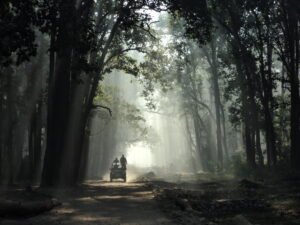
Image Credit:Deepti Dhamal, CC BY-SA 4.0,
- Jim Corbett National Park is a national park in India located in the Nainital district of Uttarakhand state.
- In 1956, nearly a decade after India’s independence, Hailey National Park was renamed Jim Corbett National Park to honor hunter-naturalist Jim Corbett, a key figure in its 1936 establishment as India’s first national park.
- Launched as the inaugural site of the Project Tiger initiative in 1973, the park plays a vital role in conserving Bengal tigers within its sub-Himalayan ecosystem.
- Encompassing dense moist deciduous forests, primarily sal, haldu, peepal, rohini, and mango trees, the park covers 73% forest and 10% grasslands, supporting 110 tree species, 50 mammals, 580 birds, and 25 reptiles.
- As an ecotourism hub, it hosts 617 plant species and a vibrant array of wildlife, showcasing Uttarakhand’s rich biodiversity in the Nainital and Pauri Garhwal districts.
Gangotri National Park
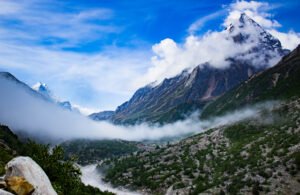
Image Credit:Gauravkaintura1234, CC BY-SA 4.0,
- Gangotri National Park is a national park in Uttarkashi District in Uttarakhand state of India established in 1989. covering about 2,390 km square. Its habitat consists of coniferous forests, alpine meadows and glaciers.
- Gangotri National Park hosts the snow leopard. Currently, 15 mammal species and 150 bird species are recorded within the park, including Asian black bear, brown bear , musk deer, blue sheep, Himalayan tahr, Himalayan monal, Koklass, Himalayan snowcock , pheasants, partridges, doves, pigeons, and Himalayan barbet.
Govind Pashu Vihar National Park
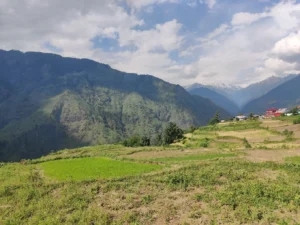
- Govind National Park and Govind Pashu Vihar Wildlife Sanctuary are protected areas covering an area of about 958 sq km. Upper Tones Valley was notified as a Sanctuary in 1955 while Govind National park was notified in 1991.
- The region boasts varied climatic zones – sub-tropical, temperate and alpine – that results in diverse flora, including Himalayan cedar, rhododendron, Himalayan spruce, Himalayan yew, beech, spikenard.
- As many as 70 species of butterflies, 20 species of mammals and 100 species of birds have also been recorded here Known for its snow leopards and Himalayan black bears.
Nanda Devi National Park

- Situated in Chamoli district, Uttarakhand, India, encompassing the Nanda Devi peak (7,816 m) in the Garhwal Himalayas.
- Founded in 1982 as Sanjay Gandhi National Park, later renamed Nanda Devi National Park.
- Designated a UNESCO World Heritage Site in 1988, expanded in 2005 to include the Valley of Flowers National Park within the Nanda Devi Biosphere Reserve.
Rajaji National Park

- Located in Haridwar, Dehradun, and Pauri Garhwal districts, Uttarakhand. In 1948, the area was created as Rajaji Sanctuary, and Rajaji, Motichur and Chila area and later as Rajaji National Park in 1983.
- In 2015, the government approved a proposal to grant Rajaji National Park the status of a tiger reserve.It is Known for its elephants and scenic Shivalik hills.
- More than 500 Elephants, 12 Tigers, 250 Panthers and good prey base including Spotted Deer, Sambhar, Wild Boar, Barking deer, Goral Two kinds of Bears Himalayan Black and Sloth, and over 400 bird species.
Valley of Flowers National Park
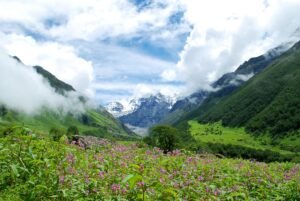
Image Credit:By Alosh Bennett – Flickr: valley of flowers, CC BY 2.0, Link
- Valley of Flowers National Park is an Indian national park which was established in 1982. It is located in Chamoli in the state of Uttarakhand and an UNESCO World Heritage Site Famous for alpine flowers and the variety of flora.
- This highly diverse region supports rare and endangered species, such as the Asiatic black bear, snow leopard, musk deer, brown bear, red fox, and blue sheep. The park is also home to birds like the Himalayan monal pheasant and other high-altitude avian species.
West Bengal – 6 National Parks
the enchanting splendor of West Bengal’s six national parks, where tidal mangroves, Himalayan slopes, and verdant forests nurture rare wildlife, crafting a tranquil haven for nature enthusiasts. Covering approximately 3,883.92 sq km, these parks preserve West Bengal’s vibrant biodiversity. From winding creeks to lofty ridges, they call with timeless allure. Each park weaves a vivid tapestry of nature’s lasting beauty
Sundarbans National Park
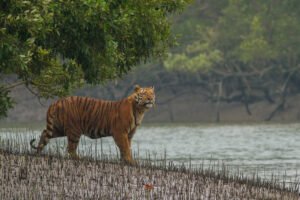
Image Credit:By Soumyajit Nandy – Own work, CC BY-SA 4.0, Link
- Sundarbans National Park is in West Bengal, India, and core part of tiger reserve and biosphere reserve. The Sundarbans covers 10,000 km2 of land and water (more than half of it in India, the rest in Bangladesh) in the Ganges delta. It contains the world's largest area of mangrove forests.
- The present Sundarban National Park was declared as the core area of Sundarban Tiger Reserve in 1973 and a wildlife sanctuary in 1977. On 4 May 1984 it was declared a national park. It is a UNESCO World Heritage Site inscribed in 1987
- A number of rare or endangered species live in the park, including tigers, aquatic mammals, birds and reptiles and known for its mangroves and Bengal tigers.
Buxa National Park
Image credit:Arijit Kisku, CC BY-SA 4.0,
- Buxa Tiger Reserve is a tiger reserve and national park in northern West Bengal, India, covering an area of 760 km. Buxa was initially declared a forest reserve in 1876 under British colonial rule
- In 1983 declared as wildlife sanctuary to protect its diverse flora and fauna.and after that Buxa was also designated as a Tiger Reserve under Project Tiger, India’s flagship conservation program.
- On December 5, 1997, the core area of Buxa Tiger Reserve, covering approximately 117.10 km², was officially declared a national park
- The main carnivores of buxa tiger reserve include Indian tiger, leopard, clouded leopard, hog badger, Jungle cat, leopard cat, sloth bear,hyaena,jackal, mongoose, fox, wild dog marbled cat and golden cat where reported earlier but in recent years most hub most of them have not been sighted.
Gorumara National Park

Image Credit: By Jonoikobangali – Own work, CC BY-SA 3.0, Link
- Located in Jalpaiguri district, West Bengal Having been a reserve forest since 1895, Gorumara was declared as a Wildlife Sanctuaryin1949, on account of its breeding population of Indian rhinoceros. It was granted official status as an Indian National Park on 31 January 1992.
- The park has recorded fifty species of mammals, 194 species of birds, 22 species of reptiles, 7 species of turtles, 27 species of fish, and other macro and micro fauna.
- Sal forests with common teak, Bombax (also known as silk cotton tree or Shimul), rain tree (Shirish or Albizia saman lebbeck),
Bamboo groves, terai grassland vegetation and tropical riverine reeds
Neora Valley National Park
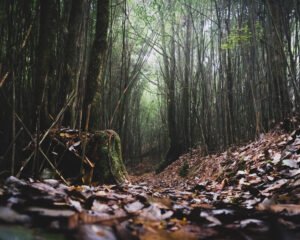
Image Credit:Kunal Bhowmik, CC BY-SA 4.0, via Wikimedia Commons
- Neora Valley National Park is a national park in Kalimpong district, West Bengal, India that was established in 1986. Spread over an area of 88 km square. it is a rich biological zone in eastern India.
- Known for its sub-alpine forests red panda in the pristine undisturbed natural habitat with rugged inaccessible hilly terrain and rich diverse flora and fauna.
Singalila National Park
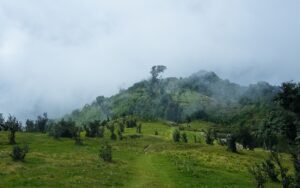
Image Credit:By Spattadar – Own work, CC BY-SA 4.0, Link
- Singalila National Park is a national park of India located on the Singalila Ridge at an elevation of more than 2,300 metres above sea level, in the Darjeeling district of West Bengal.The park was declared a wildlife sanctuary in 1986, and was made an Indian national park in 1992.
- The park has a number of small mammals including the red panda, leopard cat, barking deer, yellow-throated marten, wild boar, pangolin and pika. Larger mammals include the Himalayan black bear, leopard, clouded leopard, serow and takin. Tigers occasionally wander into the area, but do not have a large enough prey base to make residence in these forests feasible.
- Its Famous for its Sandakphu peak and Himalayan vistas.
Jaldapara National Park

- Jaldapara National Park Situated in Alipurduar district, West Bengal Originally established as Jaldapara Wildlife Sanctuary in 1941, it was upgraded to Jaldapara National Park in 2012, with a primary focus on conserving the Indian one-horned rhinoceros.
- Jaldapara National Park Spans 216.51 km² of savannah grasslands and riverine forests, hosting diverse wildlife like elephants, gaur, and over 240 bird species, including the rare Bengal florican.
- Jaldapara National Park, primarily a savannah landscape with tall elephant grasses, is renowned for its Indian one-horned rhinoceros population, the second largest in India after Kaziranga National Park. The park also supports diverse wildlife, including Indian leopards, elephants, sambar, barking deer, chital, hog deer, wild boar, and gaur.
India's national parks are full of magic and variety. Each protected area is a gateway to amazing wildlife, beautiful scenery, and important conservation. National parks in India are great places to get close to nature and have memorable experiences, whether you're an eco-traveler, a student, or an adventurer. Explore, enjoy, and help protect India's amazing natural history in national parks for your next vacation that will be truly memorable.





